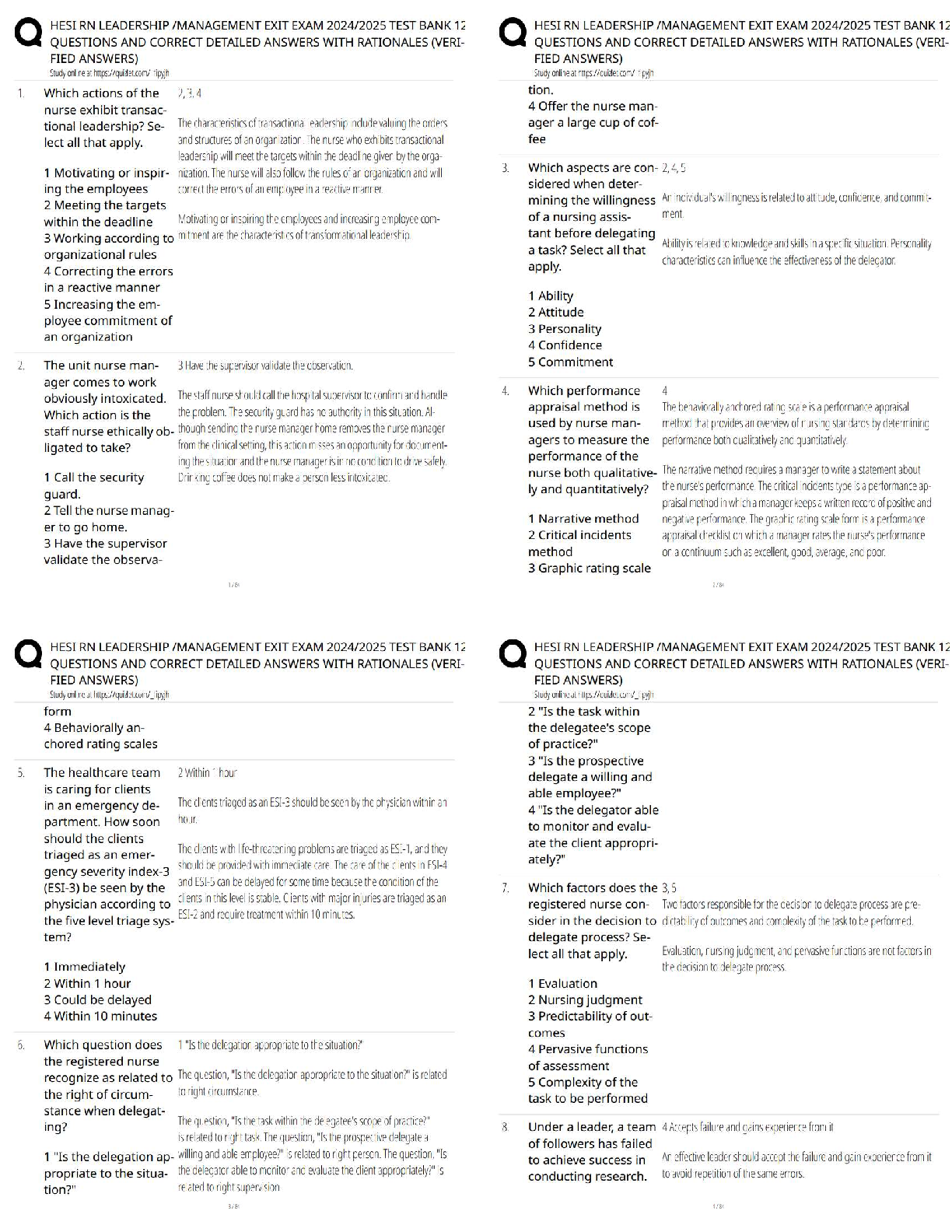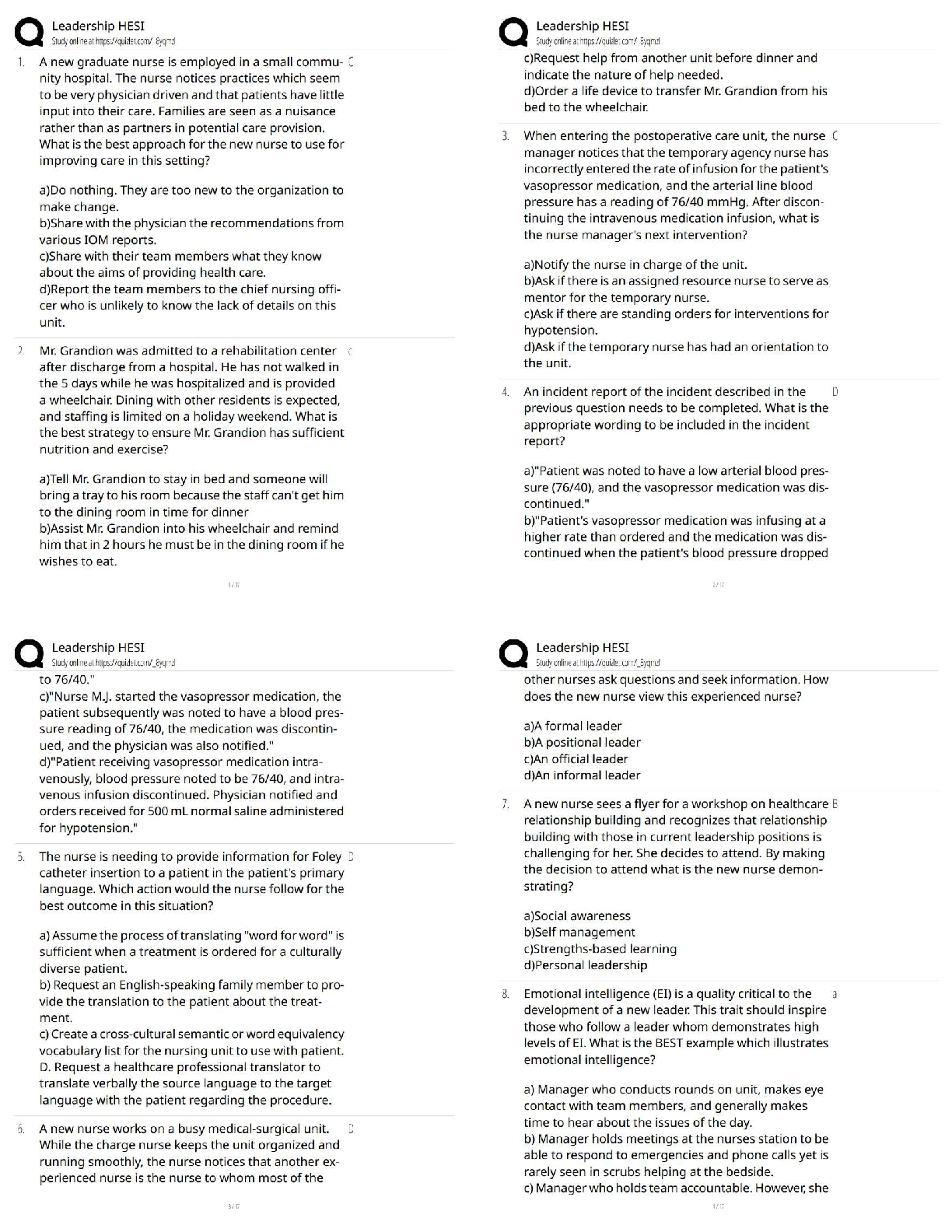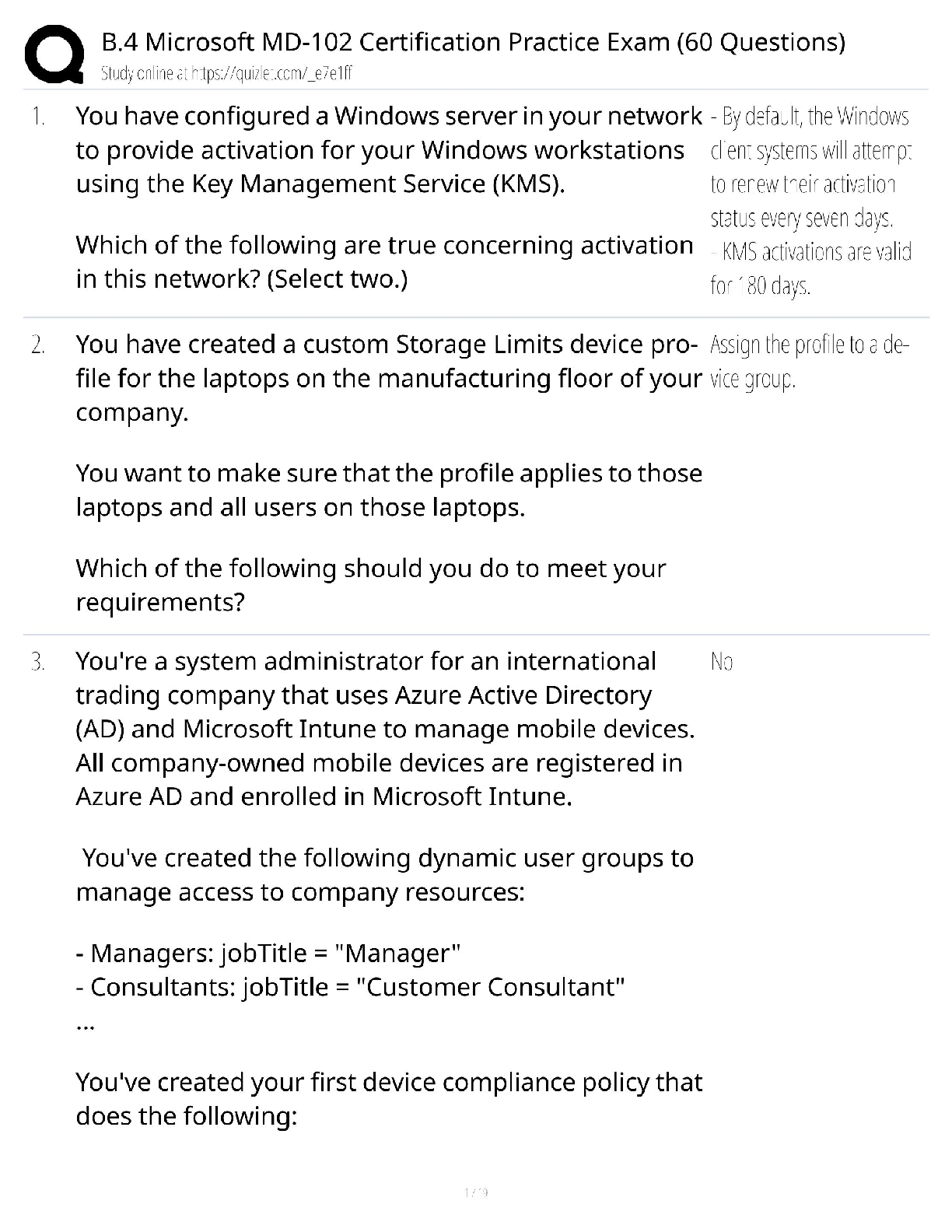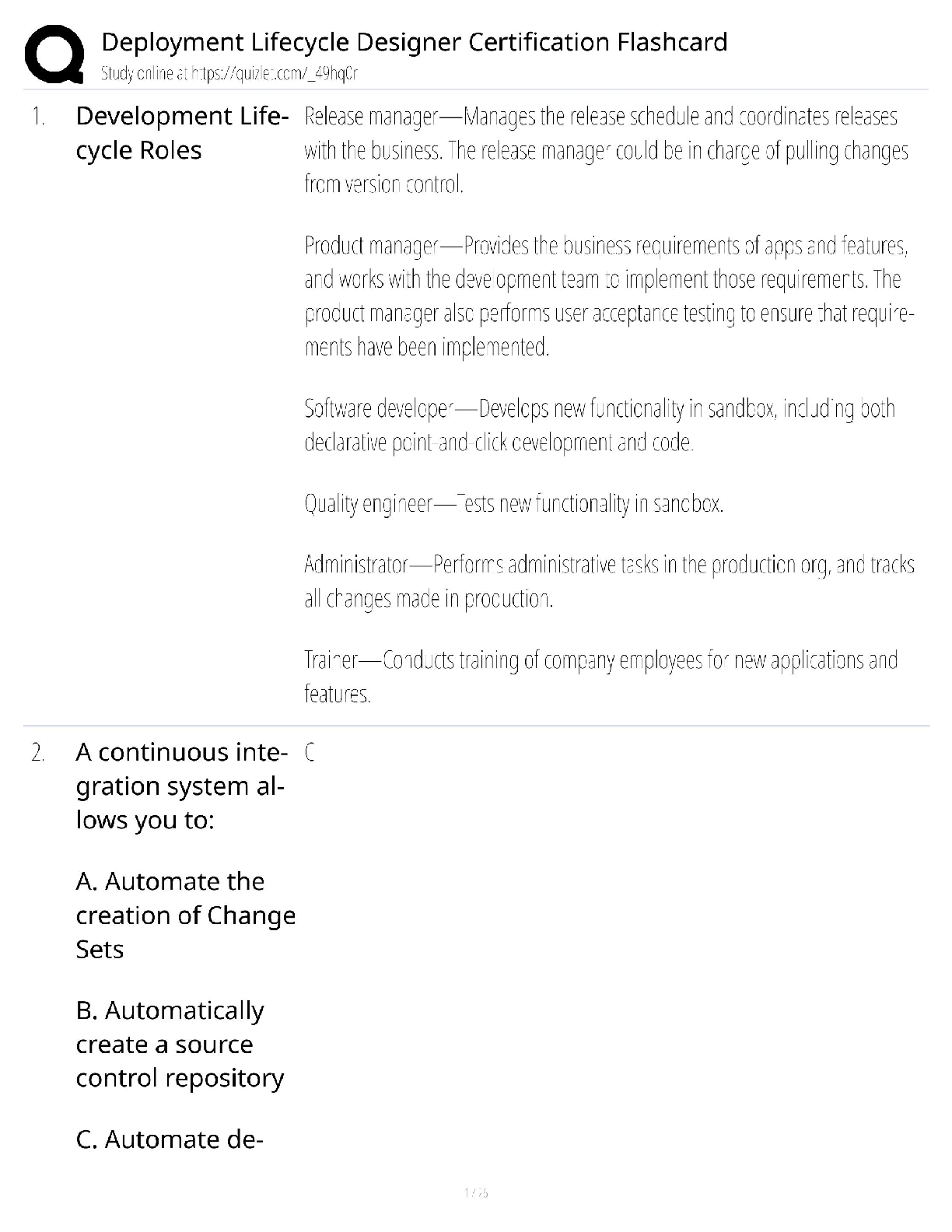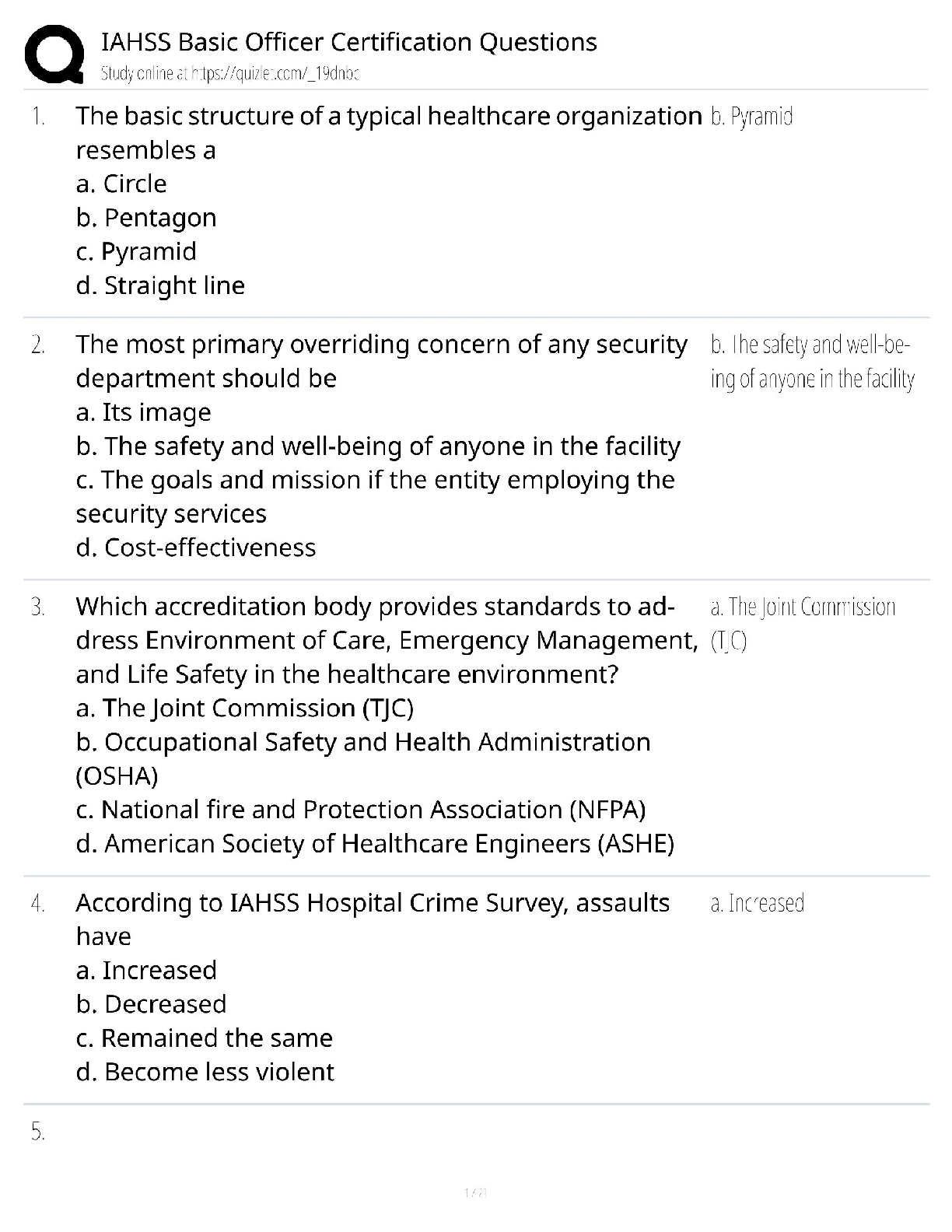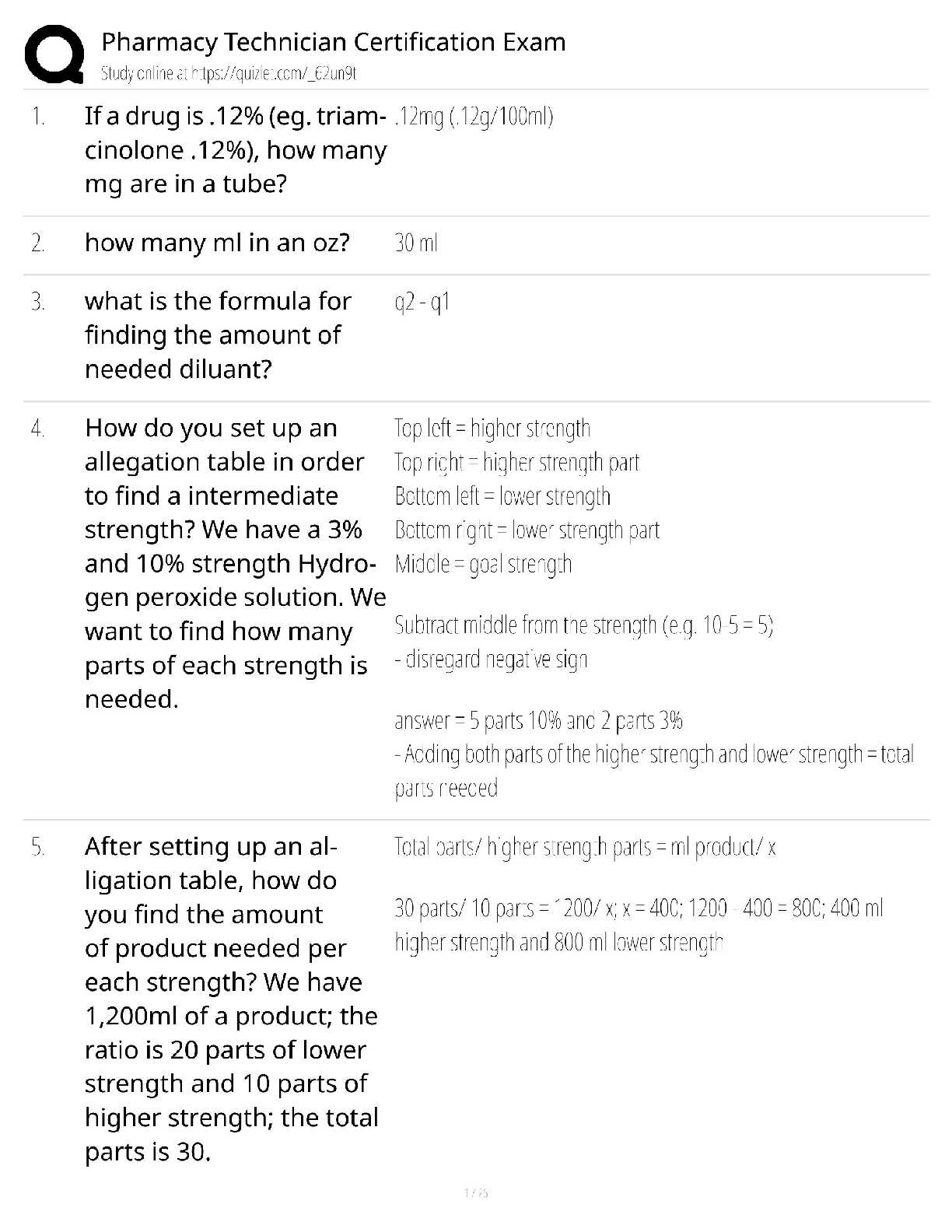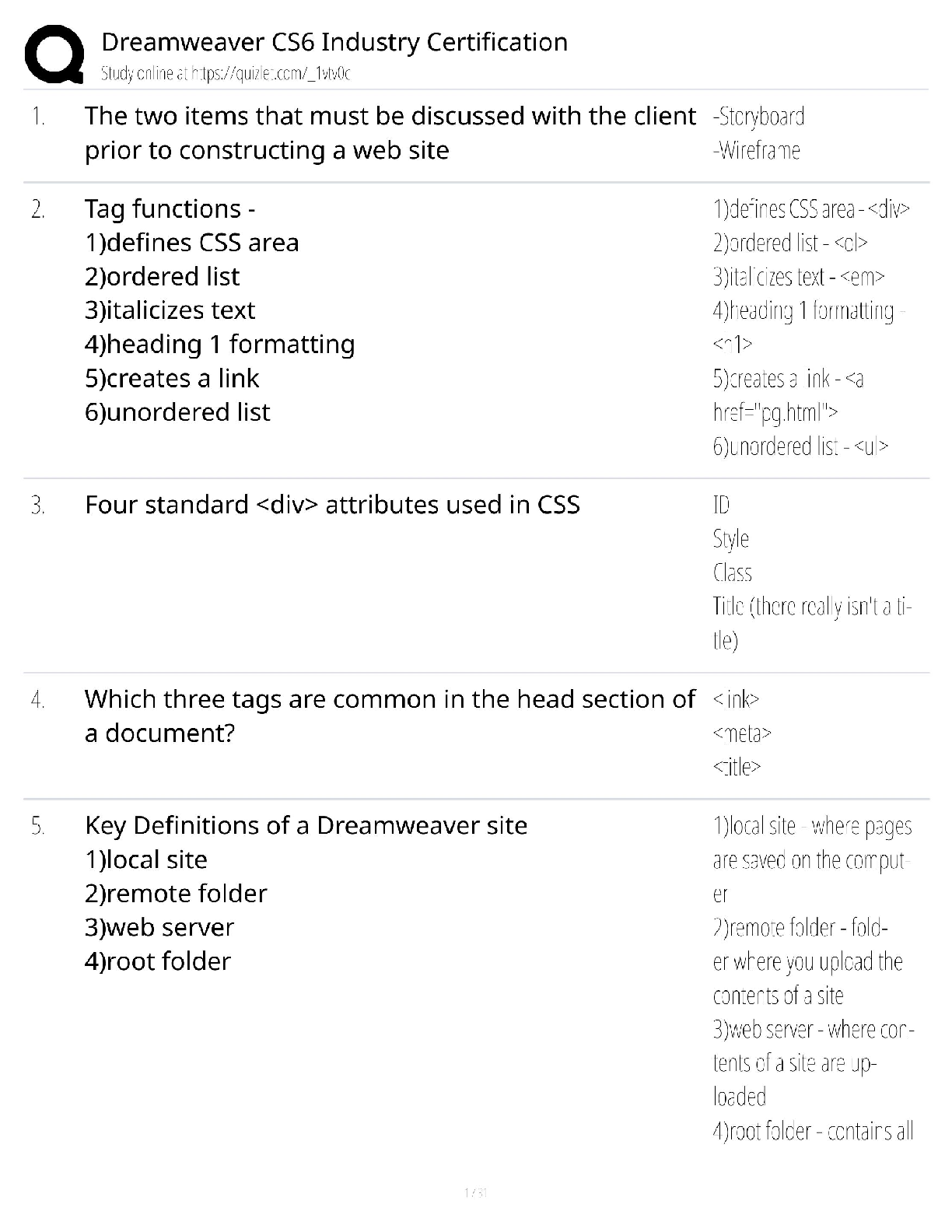BioChemistry > QUESTIONS & ANSWERS > Biochem chapter 12 test questions and answers updated solution (All)
Biochem chapter 12 test questions and answers updated solution
Document Content and Description Below
Biochem chapter 12 test questions and answers updated solution Package Title: Pratt & Cornely Test Bank Course Title: Pratt & Cornely Chapter Number: 12 Question type: Multiple Choice ... 1) Plants are considered . A) chemoautotrophs B) photoautotrophs C) chemoheterotrophs D) photoheterotrophs E) none of the above 2) Energy is generated during , the breakdown of larger molecules into smaller while energy is consumed during , the building of larger molecules from smaller ones. A) reduction reactions; oxidation reactions B) autotrophic reactions; heterotrophic reactions C) catabolic reactions; anabolic reactions D) hydrolysis reactions; condensation reactions E) none of the above 3) Digestion of food by mammals converts into which can be absorbed from the intestines. A) proteins; dipeptides and tripeptides B) polysaccharides; monosaccharides and disaccharides C) cholesterol; acetyl CoA D) nucleic acids; polynucleotides E) triacylglycerols; fatty acids 4) Digestion of food utilizes enzymes that catalyze reactions. A) hydrolysis B) reduction C) condensation D) oxidative E) group transfer 5) Which of the following is used to move lipids around the bloodstream? A) micelles B) liposomes C) liposuctions D) lipoproteins E) cholesterol esters 6) The bulk of triacylglycerols in the human body are stored in . A) liver cells B) adipocytes C) muscle cells D) nerve cells E) lipoproteins 7) The stores glucose as glycogen and converts excess glucose to . A) muscle; amino acids B) adipose tissue; fatty acids C) liver; fatty acids D) brain; energy E) none of the above 8) Amino acids can be converted to . A) carbohydrates B) fatty acids C) nucleotides D) peptides E) all of the above 9) Which of the following is mobilized for energy use by a phosphorolysis reaction, not a hydrolysis? A) glycogen B) protein C) triacylglycerols D) polynucleotides E) cholesterol esters 10) Degradation of proteins within a cell can occur within the or by use of . A) endoplasmic reticulum; protease enzymes chymotrypsin and trypsin B) Golgi apparatus; protease enzymes chymotrypsin and trypsin C) endoplasmic reticulum; a proteasome D) lysosome; a proteasome E) mitochondria; ubiquitin 11) The -terminus of ubiquitin is linked to a residue of proteins to be degraded. A) N; Asp B) N; Glu C) C; Lys D) C; Ser E) C; Tyr 12) Which of the following molecules is involved with the oxidation of glucose, synthesis of fatty acids and oxidation of fatty acids? A) pyruvate B) acetyl-CoA C) alanine D) oxaloacetate E) glyceraldehyde-3-phosphate 13) A reaction that results in the loss of electrons from a molecule is a(n) . A) reduction B) ligation C) hydrolysis D) oxidation E) phosphorolysis 14) Which of the following is more highly oxidized than acetaldehyde? A) ethane B) ethanol C) ethylene D) ethylene glycol E) acetic acid 15) The oxidized form of NADH is . A) NADH+ B) NAD+ C) NADH D) NADH2 E) none of the above 16) Which of the following molecules is in the most reduced state? A) methane B) formaldehyde C) formic acid D) methanol E) carbon dioxide 17) The conversion of a carbohydrate into CO2 is a(n) process; the conversion of CO2 into a carbohydrate is a(n) process. A) reductive; oxidative B) endergonic; exergonic C) exergonic; endergonic D) oxidative; exergonic E) endergonic; reductive 18) Which of the following is a lipid-soluble electron carrier in its reduced state? A) NADPH B) NADH C) NAD+ D) ubiquinol E) ubiquinone 19) Which of the following is correct regarding metabolic pathways? A) most pathways are isolated from other pathways B) the activity of most pathways is not regulated C) all cells within a multi-cellular organism contain the same pathways D) anabolic pathways never occur at the same time as catabolic pathways E) none of the above are correct 20) Which of the following is correctly described? A) proteome: the complete set of proteins present in a cell at a given time B) metabolome: the complete set of metabolic enzymes active in a cell at a given time C) transcriptome: the complete set of proteins being synthesized at a given time D) genome: the complete set of genes that are expressed at a given time E) none of the above 21) Which of the following is an essential amino acid? A) Ala B) Val C) Cys D) Tyr E) Gly 22) Which of the following vitamins is correctly paired with its biochemical function? A) folic acid: carboxylation reactions B) biotin: decarboxylation reactions C) riboflavin: acyl transfer reactions D) pyridoxine: amino-group transfer reactions E) pantothenic acid: redox reactions 23) Which of the following vitamins is correctly paired with the disease that is caused by its deficiency? A) biotin: scurvy B) pantothenic acid: beriberi C) nicotinamide: pellagra D) thiamine: anemia E) folic acid: rickets 24) When a reaction is at equilibrium, the DG is equal to . A) 1 B) 0 C) -1 D) ΔG°¢ E) none of the above 25) If the ΔG°¢ is known, how can Keq be calculated? A) K = log e(ΔG°¢/RT) B) K = e(ΔG°¢/TDS) C) Keq = RT ln ΔG°¢ D) K = e-(ΔG°¢/RT) E) Keq = ln (ΔG°¢/TDS) 26) For the following reaction, calculate the Keq at 25°C. succinyl-CoA + acetoacetate acetoacetyl-CoA + succinate ΔG°¢ = -1.25 kJ/mol A) 0.602 B) 1.00 C) 1.66 D) 3.21 E) 4.22 ´ 102 27) For the following reaction, calculate the ΔG°¢ at 37°C. glucose-6-phosphate fructose-6-phosphate Keq = 0.517 A) -2.87 kJ/mol B) -1.70 kJ/mol C) 0.203 kJ/mol D) -0.738 kJ/mol E) 1.70 kJ/mol 28) For the following reaction, calculate the ΔG at 37°C, given concentrations for glucose-1- phosphate of 25 mM and glucose-6-phosphate of 1 mM. glucose-1-phosphate glucose-6-phosphate ΔG°¢ = -7.1 kJ/mol A) -15.4 kJ/mol B) -8.1 kJ/mol C) -6.1 kJ/mol D) 1.2 kJ/mol E) none of the above 29) What is the intracellular glucose concentration if the ΔG for the following reaction is -20.1 kJ/mol at 37°C and concentrations for glucose-6-phosphate and phosphate are both 1 mM? glucose-6-phosphate glucose + Pi ΔG°¢ = -13.8 kJ/mol A) 1.9 mM B) 87 mM C) 1.9 mM D) 27 mM E) 87 mM 30) Which of the following describes the bonding of the three phosphates to adenosine in ATP? How many phosphoanhydride bonds are found in ATP? A) one phosphoanhydride bond, two low energy phosphate esters B) two phosphoanhydride bonds, one low energy phosphate ester C) three phosphoanhydride bonds, one low energy phosphate ester D) three phosphoanhydride bonds E) none of the above 31) If the following reactions were coupled, what would be the overall ΔG°¢? glucose + Pi glucose-6-phosphate ΔG°¢ = 13.8 kJ/mol ATP + H2O ADP + Pi ΔG°¢ = -30.5 kJ/mol A) 44.3 kJ/mol B) 16.7 kJ/mol C) 0 kJ/mol D) -16.7 kJ/mol E) -44.3 kJ/mol 32) Generally speaking, ATP is produced by reactions and used by reactions. A) catabolic; anabolic B) anabolic; catabolic C) endergonic; exergonic D) oxidation; reduction E) reduction; oxidation 33) Which of the following factors contributes to the highly exergonic nature of ATP hydrolysis? A) removal of phosphate from the cytoplasm B) addition of water to the hydrophilic ATP molecule C) decrease in negative-ion repulsion in ATP D) low energy of activation for the hydrolysis E) none of the above 34) Which of the following has the most spontaneous hydrolysis? A) 1,3-bisphosphoglycerate B) phosphocreatine C) glucose-1-phosphate D) pyrophosphate E) phosphoenolpyruvate 35) In highly active muscle, is used to regenerate ATP. A) phosphocreatine B) 1,3-bisphosphoglycerate C) pyrophosphate D) phosphoenolpyruvate E) acetyl-CoA 36) The ΔG°¢ for the hydrolysis of acetyl CoA is most similar to the ΔG°¢ for the hydrolysis of . A) 1,3-bisphosphoglycerate B) ATP C) glucose-1-phosphate D) glucose-6-phosphate E) phosphoenolpyruvate [Show More]
Last updated: 3 years ago
Preview 1 out of 12 pages

Buy this document to get the full access instantly
Instant Download Access after purchase
Buy NowInstant download
We Accept:

Reviews( 0 )
$8.50
Can't find what you want? Try our AI powered Search
Document information
Connected school, study & course
About the document
Uploaded On
Nov 01, 2020
Number of pages
12
Written in
All
Additional information
This document has been written for:
Uploaded
Nov 01, 2020
Downloads
0
Views
148

 answers.png)











